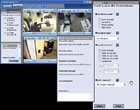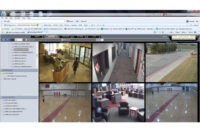VIDEOSurveillance: IP:Leverage Your Existing Infrastructure

Multi-factor alarm architecture leverages multiple components in a security infrastructure for more proactive event response. A rules engine helps the enterprise take its security policies and makes them into automatically executable processes and alarms. Photo courtesy: Verint Systems, Denver, Colo.
The world of IP came into sharper focus at the recent International Security Conference in Las Vegas where, it seems, every other booth was displaying IP-based security video, access controls, security management and monitoring.
Powerful, IP-based platforms empower enterprises, their security operations and the bottom line performance of the organization. On the image side, standards-based and IT-friendly platforms provide interoperability with other security and enterprise assets with the goal of simplifying the management of large-scale, distributed video operations.
To promote the most effective use of existing security resources and enable an organization to rapidly respond to security events, IP-based video management platforms must distill large volumes of video, audio, access control and sensor data into actionable intelligence – timely, mission-critical security information that can be readily understood and acted upon, according to Mariann McDonagh, Verint Systems, Denver, Colo.
Multi-factor alarm architecture
Leveraging multiple components in a security infrastructure for more proactive event response is commonly referred to as multi-factor alarm architecture (MFAA).For most organizations, the challenge is not how to capture information but how to distill the most timely and important data captured by a broad array of security systems. MFAA bridges hardware, software and IT systems to transform structured and unstructured data into the intelligence that equips organizations to effectively respond to threats and breaches.
MFAA combines security system and sensor data with mission-critical video and powerful analytics to pinpoint significant events, images and data. Then the intelligence is sent to the right people, wherever they are located: to consoles and Web browsers, physical security systems, video walls, mobile phones and even PDAs.
Today’s security systems generate vast amounts of data from a variety of sources in diverse formats. Digital video and recorded audio can be analyzed at the network edge and transmitted over wire-line and wireless networks, where it is stored in data repositories. Sophisticated security sensors and access control devices equipped with chemical, biometric and other screening technologies are taking the place of manned security checkpoints and guard stations, said McDonagh. Even traditional fire alarms have been upgraded to allow communication with automated fire suppression systems.
Security device standards continue to evolve, but integration technologies now can translate the diverse output formats of these devices and communicate in a universal language.
Software development kits
Multi-factor alarm architecture ensures the long-term investment protection of the systems that comprise a security network by harnessing their aggregate power and the resulting actionable intelligence to enhance the overall enforcement of security procedures.In order to facilitate the information mobility required by an MFAA, an IP-based platform must include a robust software development kit (SDK). It facilitates integration of complementary security, business and information technologies such as access control systems, cameras, analytic solutions, point-of-sale applications, etc. A comprehensive SDK should include pre-defined integrations to most major vendor solutions, advised McDonagh. This increases the flexibility of an MFAA and allows an organization to select the video, business and security solutions that best fit their needs.
Once the devices in an MFAA are able to communicate with each other, an organization must establish rules to define how they interact. IP-based security video platforms from leading vendors provide sophisticated rules-based engines that incorporate data from various security devices along with video analytics to provide automatic event notification, video distribution and process activation in response to events and behaviors.
Automated event detection and response is a key advantage provided by an MFAA. It enables an organization to proactively address potential threats and promote optimal response to emergency situations.
In this regard, IP-based video management platforms support MFAA with sophisticated analytical tools that actively identify threats before they escalate. Video analytics combine information from access control devices and perimeter sensors with video footage of people or vehicles crossing virtual perimeters or entering restricted areas. This comprehensive view of a security threat helps to eliminate false alarms and ensures that an appropriate and proactive response is initiated.
In addition, IP-based video platforms provide the capability to distribute surveillance video to multiple disparate agencies in order to reduce response time and effectively manage critical scenarios. An MFAA can deliver a wide array of responses to operations centers and law enforcement command posts.
IP-based video management platforms are ushering in a new era of complex, automated security methodologies. MFAAs are empowering organizations to use combine existing security resources for more advanced processes that effectively respond to dynamic security threats.
So What Does a Rules Engine Do?
Rules engines allow an organization to easily convert security policies into executable processes.Here is an example of how rules would define an MFAA process:
Detect all instances of subjects triggering specific access controlled door and entering secure area between 10:00 pm and 5:00 am.
Commence recording on all passive cameras in proximity once access door is breached to provide a 360? view of the area.
Send alarm notification to wireless device of security personnel in closest proximity for further investigation.
Push video feeds of subject entering secure area to video wall in centralized command center.
This example from Mariann McDonagh of Verint Systems illustrates how the data from multiple access control and video surveillance cameras is collected, distilled and transformed into actionable intelligence in an MFAA.

IP’s ISC Takeoff
Zalud’s Blog (go to http://blog.securitymag.com for updated content) at last month’s International Security Conference reported on numerous technology event. An important one was the first ever meeting of the IP UserGroup USA, an independent security technology forum dedicated to networked security and building management solutions. Security Magazine’s reporter mostly saw vendors and researchers at the meeting and who have identified with IP security video – indicating the evolution to IP driven by technologies and suppliers at first. Pictured here: Kevin Fagen, Director, IP Security Events and Media Limited, and Paul Hennings, Editor, IPFocus Director, who flew in from England to arrange the event.The IP UserGroup community of 10,000 mostly UK members is dedicated to understanding and promoting IP networked technology and its use in security, surveillance and building management solutions. Some of the activities and benefits the IP UserGroup offers current members and its new members in the US: IP-in-Action LIVE educational forums where members and guests come together for seminars, master classes, workshops and hands-on technology demonstrations and for discussion and networking; a constant stream of education and information sharing in the IP UserGroup “virtual community” through e-letters and technical bulletins.
Looking for a reprint of this article?
From high-res PDFs to custom plaques, order your copy today!







